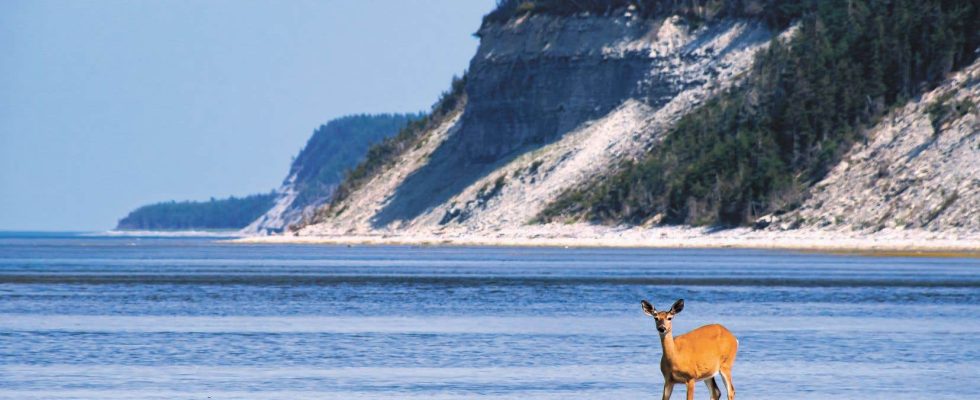What fascinates Mathieu-Robert Sauvé so much in front of this monument of the St. Lawrence River that is Anticosti Island? “Who goes to Anticosti, apart from those who have money to fish or hunt? I flew over it several times, on my way to somewhere else. But when I set foot there for the first time, I had a shock,” explains the science journalist in an interview. To the point of undertaking to travel, last summer, the entire island on foot, alone…
“I discovered a continent! For me, it was a love shock. I believe, like the geographer Louis-Edmond Hamelin, that we must “walk” the territory to appropriate it, to know it. I wanted to dive into this world. »
From the outset, Sauvé affirms that with more than 1,400 species of fossils recorded, Anticosti is undoubtedly one of the most beautiful sites in the world, on par, he says, with the Yellowstone Park in the United States or the Great Barrier Reef in Australia. The photos published in this book, for the most part the fruit of the work of Gaétan Laprise (known as Alex), plead in his favor.
“Gaétan Laprise is perhaps the guy who knows the island best,” says Sauvé. “He knows everything about the island. He searched everything. He went everywhere. He’s the honest Renaissance man! »
The cherry, the cake
In this richly illustrated book, perhaps the best popular work to date devoted to Anticosti, Mathieu-Robert Sauvé notes, following Professor André Desrochers of the University of Ottawa, that “while crossing the island, we see ten million years go by.” There are in fact so many fossils on the island that experts use a nice pictorial expression to talk about them: a “fossil cake”.
In 1963, recalls Mathieu-Robert Sauvé, a young journalist named Pierre Bourgault arrived on the island. He is accompanied by legendary photographer Antoine Desilets. Bourgault paints “a scathing portrait” of Consolidated Paper, the company to which the wealthy family of industrialist Henri Menier ceded this island. “For Bourgault, it was a regime of exploitation without a name! We were in a feudal regime. »
At the beginning of the 1970s, the tycoon Paul Desmarais, big boss of Power Corporation, now controlled the island. It is exploited for its wood. Desmarais invites politicians as he pleases. Pierre Elliott Trudeau, it seems, loves the place. And Desmarais ends up suggesting, since his business there is less good than he would like, that the state buy the place to create a park. In 1974, the Quebec government became the owner, while authorizing the maintenance on site of a social and political organization marked by years of exploitation.
Even in the 1960s, as Mathieu-Robert Sauvé well observed, “the island was so subject to its owners that the inhabitants did not have the right to own their own house”. Everything is rented to their employer, who thus holds their fate all the more easily in their hands.
The history of Anticosti has been described more than once, but Sauvé has the merit of making the whole story digestible, navigating at ease between various periods and documents. “When the company wanted to leave the island in the early 1970s,” explains Mathieu-Robert Sauvé in an interview, “it simply wanted to close it, telling people to leave. » This is without mentioning the fact that before the war, Anticosti was also almost ceded to representatives of the Nazi regime. Could Anticosti have become an outpost for the conquest of America?
The chocolate island
Old photos of the island, those dating from the time when French industrialist Henri Menier, a chocolate magnate, owned it, are quite exceptional. They leave you speechless. The villa of the extremely wealthy person, its outbuildings, all the surroundings had been finely modeled by the vision of this great lord. Unfortunately, until today, the traces that have survived from this era have received very little attention in terms of preservation. In 1953, people even went so far as to set fire to Château Meunier, an architectural masterpiece, to avoid having to pay insurance costs!
Outdoor lover, Mathieu-Robert Sauvé speaks of the Jupiter, Chicotte, Galiote, Bec-Scie, Gamache and other rivers on the island as an expert and, above all, as an admirer. “Even my son, who is not an outdoor enthusiast, loved Anticosti! »
Pages and pages are devoted to the dazzling flora and fauna of the island, all crossed with considerations based on science, geology, biology, history. What better could we have hoped for to camp Anticosti Island in a single flow? Without a doubt, this book immediately stands out as a basic reference for this difficult-to-access territory.
Long attached as a journalist to the institutional journal of the University of Montreal, former president of the Association of Scientific Communicators of Quebec, long-time collaborator at Quebec Science, author of several books, Mathieu-Robert Sauvé pursues a rich career at Montreal Journal.
